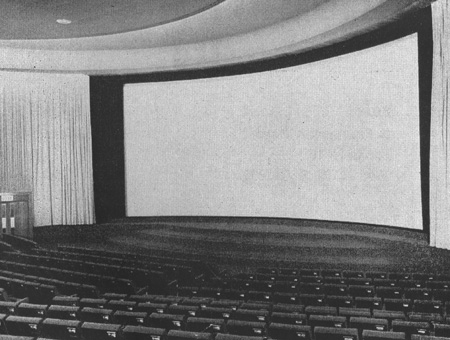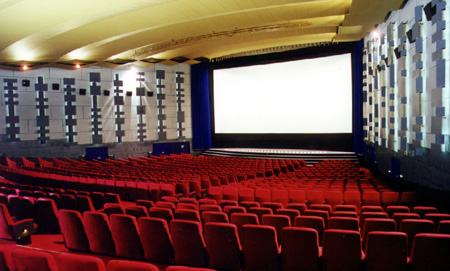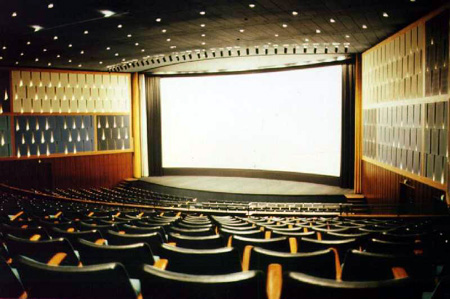Masking Configuration for 70mm Screens |
Read more
at in70mm.com The 70mm Newsletter |
| Written by: Ramon Lamarca Marques, Brian Guckian and Mike Taylor | Date: 17.01.2010 |
 Curved
screen with movable side masking (unidentified location).
Courtesy Mike Taylor / PPT Collection Curved
screen with movable side masking (unidentified location).
Courtesy Mike Taylor / PPT CollectionAs the 70mm format is physically larger than 35mm, it follows that corresponding screen size should also be larger. Though this may seem obvious, there are different ways of achieving this in practice. A common technique is to have the 2.21:1 aspect ratio of 70mm share common width with 35mm 'Scope 2.39:1, and to lift the top masking for 70mm. Other cinemas have arranged the layout so that both the side masking and the top masking open out for 70mm. A movable top masking only configuration is appropriate for 70mm where additional available screen width is limited. The importance of screen masking generally should not be underestimated or neglected, as it performs an important technical function in enhancing the contrast of projected images, in addition to the more commonly cited advantage of providing a pleasing hard edge / border. Many cinemas today, whether regular or large format, do not use screen masking and this is poor practice. Additionally, in order to maximise the impact of the film experience, it is paramount that the presentation of the main feature in 70mm is completely different to any previous advertisements and/or trailers both in image resolution, sound quality and screen width and height. By using the same screen surface for advertisements and the main feature, or even having the main feature using less screen surface (the incorrect "common width" screen configuration), the impact of cinema and its differences to home cinema are diminished. Correct screen masking coupled with a good use of curtain tabs can enhance a film presentation. The 65/70mm Workshop has also previously put forward a design for a multi-format, compound curved screen that is intended to be correctly masked. [With thanks to Ben Wales for his assistance] |
More
in 70mm reading: 65/70mm Workshop Internet link: |
SCREEN MASKING FOR 70MM PRESENTATION
|
|
 Curved
screen with movable side & to/bottom masking. Imperial Bio, Copenhagen,
Denmark. Image by Thomas Hauerslev. Curved
screen with movable side & to/bottom masking. Imperial Bio, Copenhagen,
Denmark. Image by Thomas Hauerslev.When Cinerama took the cinema world by storm in 1952 it introduced a new form of cinema - The Wide Screen. Following on the heels of this development, film companies came up with other processes so as not to be outdone in the race to have wide screen for the majority of film goers, and at the same time to try and slow down the mass medium of television. Mike Todd - who had been in the forefront of Cinerama and later fell out with the company - went on to develop his own system where "Everything Came Out Of One Hole". This was Todd AO - the AO being his partner, the American Optical Company. As the 70mm format is physically larger than 35mm, it follows then that the screen size should also be greater. To the outside observer this is indeed obvious, and the screen therefore requires masking to achieve the relevant picture ratio. |
|
Kinds of Screen Frames |
|
 Curved
Todd-AO screen with movable side & to/bottom masking. 3 Falke Bio
(closed), Copenhagen, Denmark. Image by Thomas Hauerslev. Curved
Todd-AO screen with movable side & to/bottom masking. 3 Falke Bio
(closed), Copenhagen, Denmark. Image by Thomas Hauerslev.To accommodate 70mm and the other standard current ratios in 35mm using the same screen, various types of screen frames have appeared over the years taking into account the size and shape of the cinemas. Four types have been in common use: (1) Flat screen frame - free standing with stabilising rear braces. (2) Flying screen frame - with extra strength to allow for suspended cables (3) Roller screen (4) Deep Curve screen frame With the exception of the roller screen, the screen frames included the masking system as an integral part of the frame. Built within a box-like structure it carried all the guide rollers and cables linked to the motor controllers and limits. In most cases, the screen would be curved. For 70mm, the screen would be at its maximum with both top and side masking facility. In smaller cinemas where 70mm was included, maybe only side masking would operate. A fixed picture height being the norm for all ratios. Roller Screen This type of screen for 70mm is the exception, and is usually found in specialised venues such as museums. A typical example is the Pictureville Cinema at Bradford, part of the National Media Museum. The screen only carries a fixed border top and bottom. The side masking making use of the screen curtains, with a rigid edge and opening to the 70mm ratio. Deep Curved Screens These screens are usually found in the major cinemas or specialised venues, and were the pioneers for such systems as Cinerama and Cinemiracle with a 146 degree curve. Following the demise of these systems, the deep curve almost disappeared but came to the fore in 1967 with the introduction of D-150 at the Odeon Marble Arch, London. This time the curve was reduced to 120 degrees. The masking system was again an integral part of the screen frame and allowed for D-150 70mm 35mm (cinemascope and normal) and had both top and side masking, making this the ultimate presentation system. |
|
|
Go: back
- top - back issues
- news index Updated 22-01-25 |
|
